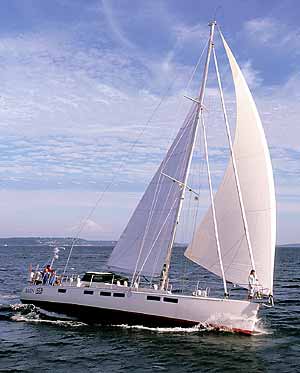 What is
the G-0?
What is
the G-0?
The newest product in the North Sails
G-Series group of cruising asymmetric sails is the G-0. The G-0 is a
modification of the racing Code 0 and is essentially an updated
"reacher/drifter" free-flying sail with a high modulus luff rope. The G-0
should be used as a furling sail and was established after a variety of
North Sails cruising customers from different geographic regions requested
free-flying reachers.
What is the Code 0?
The racing Code 0, developed for IMS boats,
is an asymmetric spinnaker designed to fly like a huge reaching jib while
just meeting the requirement of SMG = or >75% foot length so that it is
rated as a spinnaker. The racing Code 0's are just deep enough to support
the extra area if they are set up perfectly. Although a little finicky to
use, they have proven to be indispensable weapons for ocean racing boats
that are rated with asymmetric spinnakers. The effective wind range is
approximately 45 degrees apparent in 3-6 knots true wind speed and up to
100 degrees apparent in 9-11 knots true wind speed.
What is the shape of the G-0?
The G-0 has been modeled after the racing
Code 0 without the roach area dictated by the race rules and with reduced
luff curve so that the sail can be used with more sag. These modifications
have brought the SMG down from 75% to 60%. The cruising G-0 takes
advantage of the cross section shaping that was designed on the Code 0 to
support the leech roach, but it is more fair than the racing sail because
it doesn't have to be designed to hit the SMG requirement. We believe that
the G-0 will offer the cruising sailor the performance benefits of the
racing Code 0 in a much more user-friendly package.
What are the notable design differences between the
G-0 and the Code 0?
1) The Code 0 has significantly more luff
curve. Remember that no matter how hard the halyard is pulled up, this
sail is going to be set on a sagged luff rope as soon as it is
pressurized. So the excess luff curve will make a deeper entry than is
ideal. The G-0 will have a more normal looking entry, like you would
expect to see on a very deep reaching headsail.
2) The Code 0's leech is bumped to get the
mid-girth out to 75% of the foot length. On the G-0 the leech is a fair
curve. The bump has been cut off.

What is the wind range for the G-0?
The polar diagram above displays the range
in which we anticipate the cruising sailor will find the G-0 most
effective. The G-0 can be pushed into higher apparent wind angles in light
air. In fact, the Code 0 racing sails, contorted with an inhauler, have
proven to be effective as high as 36 degrees apparent in 3-4 knots of true
wind speed. However, we anticipate that in winds less than 6 knots, 95% of
our cruising customers will either be motoring or arranging to buy more
fuel. In 8 knots of wind or more, the working jib will push the boat at
acceptable speeds while sailing on angles tighter than 45 apparent. The
G-0 will come into play when the sheets have to be eased.
At the other end of the apparent wind angle,
the efficiency of the G-0 will drop off dramatically as soon as the breeze
is aft of 90 degrees. But we expect these sails to be lugged as low as
115-120 simply because they are much easier to handle than a gennaker and
there is a greatly diminished risk of a disaster because the sail is
hanging off a tight luff rope. On broad reaching angles with the wind in
the low 20-knot range, the cruising sailor can use the G-0 as a "chicken
chute".
Who will use a G-0 vs. a G-1?
The G-1 and the G-0 are close enough in size
and wind range that it is unlikely that any boat will ever have both
sails. A moderate to light displacement boat, with non-overlapping
headsails, would be a good candidate for a downwind inventory of a G-0 and
a G-3. The G-0 makes sense for this type of boat because the lack of
genoas leaves a hole in the inventory in light air tight reaching
conditions. Both the G-1 and the G-0 have the advantage of flying off a
tight luff rope, so they are both forgiving sails for cruising boats being
operated under autopilot steering. The G-0 is built with very heavy
spinnaker fabrics for small boats and polyester laminates for larger
boats, so the G-0 will work at higher apparent wind speeds than the G-1.
In general terms, a G-1 is a deeper sail
with more roach area and is intended for Nylon construction and more broad
angles. Most G-0 sails will be built from laminated fabrics and are
intended for somewhat tighter angles.
Bow Sprit Notes:
Both the G-1 and the G-0 should be set with
a very tight luff rope. The sails will not furl properly if the luff rope
is slack. Accordingly, the tack fixing point will be subjected to nearly
the same load as the head ring. This means that the tack load on a G-0 or
G-1 could be 3-4 times greater than the tack load on a running A-sail.
Accordingly, if you intend to set the sails on any type of bow pole, bow
sprit or anchor platform that does not have a stay or fixed strut opposing
the halyard, please check with the pole or boat manufacturer to make sure
you will not be exceeding the loads they anticipated.